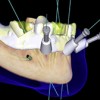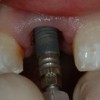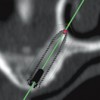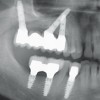Edentulism is a growing problem in our society with the numbers expected to exceed 20 million individuals by 2020. This program discusses the trends and consequences of tooth loss, and the mastication efficiency of complete dentures compared to the dentate state. Data relative to the percentage of patients satisfied or dissatisfied with their dentures is also presented.
Complete Dentures – Introduction — Course Transcript
1. 1. Introduction Eleni Roumanas, DDS and Michael Hamada, DDS Division of Advanced Prosthodontics, Biomaterials and Hospital Dentistry UCLA School of Dentistry This program of instruction is protected by copyright ©. No portion of this program of instruction may be reproduced, recorded or transferred by any means electronic, digital, photographic, mechanical etc., or by any information storage or retrieval system, without prior permission.
2. 10 11 12 13 14 1960 1970 1980 1990 Percent 30 40 50 60 1960 1970 1980 1990 Percent Edentulous 18+ yrs old Percent Edentulous 65+ yrs old Since the 1960’s there has been a dramatic decrease in the rate of tooth loss in our population. Trends In Tooth Loss Vital & Health Statistics
3. Estimates of U.S. Total Adult & Edentulous Adult Population 0 50 100 150 200 250 300 350 Millions < 18 yrs . Adult Edentulous Adults However, due to the exponential growth of our population the actual number of edentulous patients is slightly increasing over time . Because the age at which patients are becoming edentulous is older they may have greater adaptation difficulties. Vital & Health Statistics 1970 1980 1990 2000 2010 2020
4. Estimates of U.S. Total Elderly(65+yrs.) & Elderly Edentulous in One or Both Jaws 0 10 20 30 40 50 60 1970 1980 1990 2000 2010 2020 Dentate One Arch Both Arches Millions By the year 2020 approx. 30 million elderly adults will be edentulous in one or both arches. Edentulous Vital & Health Statistics
5. This chart reveals all the possible combinations of completely edentulous and partially edentulous prostheses in our present population. Denture Users in the Adult Population Redford et al(1996) NHANES Data
6. Answers to the question, “what is your lab specialty?” Type 1999 2002 % change Partial dentures 8% 24% +16% Complete dentures 18% 23% +5% Orthodontics 2% 3% +1% Implants 3% 3% 0 Full Service 16% 16% 0 Crown & Bridge 51% 49% -2% Trends in the Laboratory Industry Cornerstone Research & Marketing 2002 study of 601 laboratories Trends in the laboratory industry are showing a significant increase in the demand for complete and partial removable services. In fact the increase in removable is outpacing the growth patterns of the other restorative areas.
7. Trends in Clinical Dentistry Future Needs for Fixed and Removable Partial Dentures in the United States Douglas, J Prosthet Dent 2002 The number of people in the United States who need complete dentures will increase over the next 20 years. Dental education programs and practitioners should consider the implications of these continuing patient needs.
8. Elderly are not simply old adults . . . They vary widely in their physiologic and psychosocial characteristics and in the number and severity of diseases that they contract. (Rowe, 1985)
9. Specific Management Problems Denture support area Neuromuscular control Chewing force Salivary flow due to medication(s) Healing capacity Quality of denture bearing tissues Elderly patients require special considerations due to their compromised oral anatomy, medical and nutritional status and reduced physiologic reserves or adaptive capacity .
10. The technical details of denture fabrication are only one aspect of treatment. Of equal importance is the dentist-patient interactions or rapport. A dentist must understand denture function and its limitations and be able to guide the patient through the treatment and adaptation process. Technical ability Interpersonal Management Skills Understanding of Denture Function and Denture Limitations D E N T I S T Denture Function and Limitations
11. Consequences of tooth loss
12. Consequences of Tooth Loss Atrophy of supporting structures – Residual Ridge Resorption Maxillary loss is in vertical and palatal direction Mandibular loss is vertical and oriented along cross-sectional shape of mandible
13. Consequences of Tooth Loss Maxillary loss is in vertical and palatal direction Mandibular loss is vertical and oriented along cross-sectional shape of mandible
14. Consequences of Tooth Loss Maxillary loss is in vertical and palatal direction (0.1 mm/year sustained) Initial loss in first year greater but variable Mandibular bone resorption is 4x maxillary (varies)
15. Consequences of Tooth Loss Residual Ridge Resorption (RRR) Various Changes in Intraoral Structures Decreased Masticatory Function Loss of Facial Support and Muscle Tonus Potential Psycho-Social Effects
16. Consequences of Tooth Loss Residual Ridge Resorption (RRR) Physiologic levels of tension results in apposition (such as that transmitted by loading the PDL through natural dentition) Non-physiologic compression (as may occur under denture bases) results in resorption
17. Consequences of Tooth Loss Various Changes in Intraoral Structures include: Atrophic changes in the residual ridge leading to unfavorable changes in vestibular attachments Atrophic changes in the mucosa compromising the bearing surface Loss of teeth as “fulcrums” for function and tissue support
18. Consequences of Tooth Loss Various Changes in Intraoral Structures Affect quality of support and stability Affect ability to manipulate dentures during function Decreased Masticatory Function Although variable, forces during mastication with natural dentition may be up to 175 lbs; complete dentures, 22 to 24 lbs
19. Consequences of Tooth Loss Loss of Facial Support and Muscle Tonus
20. Consequences of Tooth Loss SUMMARY – Tooth loss results in Loss of Facial Support and Muscle Tonus Decreased Masticatory Function Potential Psycho-Social Effects The goals of denture occlusion are to help minimize the affect of these functional, aesthetic and psychological compromises.
21. A denture wearer’s ability to comminute food during mastication is markedly reduced to 1/4 or 1/7 of that of adults with natural dentitions depending on the ages of the subjects and type of food. Kapur & Soman l964; Heath 1982; Slagter et al, 1992, 1993 Dentures – Mastication Denture wearers are in a sense “oral invalids”.
22. Despite all the shortcomings edentulous pts. are quite satisfied with their complete dentures, only 5-20% of them are not. Van Waas, 1990 Denture satisfaction is influenced by various factors, including denture quality, the denture bearing area available, the quality of dentist-pt. interaction, previous denture experience and the pt’s personality & psychologic well being . Berg, 1991 Outcome from the pt’s point of view is only in part related to technical aspects of the tx. modality Vervoorn 1988, Van Waas 1990 Dentures- Pt. Satisfaction
23. Dentures- Pt. Satisfaction 66.7 % 25.6 % 7.7 % Fully Satisfied Moderately Satisfied Dissatisfied Berg E (1998); Smedley TC et al (1989); Kapur KK et al (1997) Patient satisfaction also depends upon expectations and some patients may have very unrealistic expectations. For this reason it is important to guide and educate the patient .
24. House Classification of Patients Philosophical – Rational, sensible, organized and overcomes conflicts (Expectations are real) Exacting – Methodical, precise and accurate; places severe demands (Must reach an understanding before starting treatment) Indifferent – Apathetic, uninterested, uncooperative and lacks motivation; blames dentist for poor health; pays no attention to instructions (Unfavorable prognosis) Hysterical – Emotionally unstable, excitable, apprehensive (Psychiatric help may be required)
25. Successful Treatment of Edentulous Patients Patient preparation and management Quality of denture fabrication


 Computer Guided Treatment Planning and Surgery
Computer Guided Treatment Planning and Surgery
 Single Tooth Defects in Posterior Quadrants
Single Tooth Defects in Posterior Quadrants
 Prosthodontic Procedures and Complications
Prosthodontic Procedures and Complications
 Restoration of Posterior Quadrants and Treatment Planning
Restoration of Posterior Quadrants and Treatment Planning
